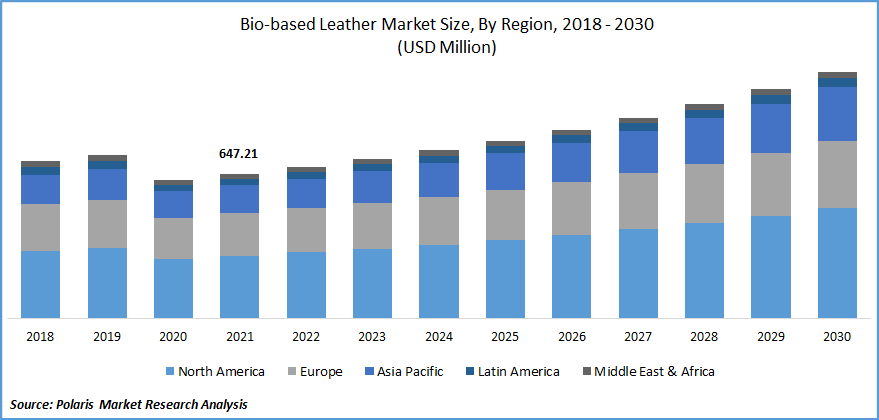
Bio-based Leather Market Share, Size, Trends, Industry Analysis Report, By Source (Cork, Corn, Leftover Fruits, Mushroom, Palm, Pineapple, Others); By End-Use; By Region; Segment Forecast, 2022 - 2030
- Published Date:Aug-2022
- Pages: 115
- Format: PDF
- Report ID: PM2538
- Base Year: 2021
- Historical Data: 2018-2020
Report Outlook
The global bio-based leather market was valued at USD 647.21 million in 2021 and is expected to grow at a CAGR of 6.2% during the forecast period. Bio-based leather is derived from natural materials such as cork, pineapple leaves, apple waste, and cactus, among others. The adoption of bio-based leather is increasing owing to the greater demand for renewable and sustainable products. They are sometimes combined with non-biodegradable components such as PU for improved durability and strength.

Know more about this report: Request for sample pages
Production of bio-based leather supports sustainability on account of reduced energy and water consumption and reduced emissions. It is also partly made from waste. It is more breathable as compared to its synthetic counterpart while offering a softer surface and enhanced scratch resistance properties.
Consumers are increasingly shifting toward bio-based leather owing to greater environmental concerns and the introduction of cruelty-free leather products. It is used for the manufacturing of accessories, footwear, garments, and home decoration products. Mushroom or Mycelium type is made using mushrooms.
Mycelium is the underground root structure of mushrooms. It offers a faster production time as it can be bred at a fast rate in different shapes, sizes, and widths. They are widely used by an Italian textile company called Grado Zero Espace. The company offers Muskin, a mushroom-based leather, which is manufactured using all-natural products.
The final product is suede-like leather offering high durability and water-repellence. Nat-2 is a German brand that manufactures mushroom-based vegetable leather. The company produces its faux leather shoes through a combination of mycelium with organic cotton and recycled water bottles.
The COVID-19 outbreak has restricted the growth of the bio-based leather market on account of reduced demand, closure of stores & malls, and operational challenges. The pandemic resulted in a disrupted supply chain and a reduced workforce. The COVID-19 outbreak hampered industries such as textile, footwear, and clothing, leading to decreased demand for the market.
Other factors restricting the market growth during the pandemic include a decline in the supply of raw materials, restrictions on the movement of goods, especially from the Asia-Pacific region, and a halt in import and export activities. Post-pandemic, the market is expected to be driven by supportive government regulations, favorable environmental policies, and the opening of distribution channels.
 Know more about this report: Request for sample pages
Know more about this report: Request for sample pages
Industry Dynamics
Growth Drivers
Increasing population, rising urbanization, especially in emerging economies, and growing disposable income drive the growth of the bio-based leather market. The rise in consumer awareness, changing lifestyles, and increasing use in diverse applications have increased the demand for the market across the globe. The introduction of stringent environmental protection policies has encouraged market players to explore new sustainable materials to eliminate tannery wastewater, sludge, and other solid waste generated by the industry.
Several campaigns associated with animal rights have been introduced across the world. Implementation of stringent regulations regarding animal welfare has encouraged the industry to turn toward cleaner, greener, and more sustainable materials and processes.
They are increasingly being used in fashion products, accessories, footwear, and furnishing. Technological advancements, greater investment in research and development, and increasing application in the automotive sector are factors expected to offer growth opportunities during the forecast period.
Report Segmentation
The market is primarily segmented based on source, end-use, and region.
|
By Source |
By End-Use |
By Region |
|
|
|
Know more about this report: Request for sample pages
Pineapple segment accounted for a significant share
The pineapple segment accounted for a major share in 2021. Piñatex is a bio-based type developed using pineapple leaf fibers. Pineapple is increasingly being used to make bio-based types to make use of agricultural waste products.
The discarded pineapple leaves are collected to extract long fibers, which are then cleaned, purified, and dried. The resultant product is then combined with corn-based polylactic acid and processed to obtain a non-woven mesh. It is then coated to impart strength, durability, and water resistance properties.
In January 2019, Hugo Boss introduced a new line of men's shoes manufactured using Piñatex. The shoes are free from any animal products and use plant-based dyes for coloring. This product launch was aimed at achieving sustainability across the supply chain by the company.
Footwear segment dominated the global market in 2021
The footwear segment accounted for a major share in 2021. Bio-based leather is increasingly being used in the manufacturing of footwear as it is cruelty-free and environment-friendly. Use of bio-based leather in footwear offer aesthetics in feel and appearance. The footwear industry is increasingly investing in the development of sustainable options. The use of bio-based leather in the manufacturing of footwear offers product recyclability or biodegradability at the end of life.
In February 2021, Allbirds, a footwear brand, collaborated with Natural Fiber Welding through an investment of $2 million for affordable production of plant-based types in the fashion industry. In January 2021, Adidas announced the launch of sneakers manufactured using mushroom-based type.
The sneakers are entirely vegan and developed using created using mycelium. In 2020, the company introduced several plant-based versions of classic sneakers. The launch was aimed at the company's initiative toward the use of sustainable materials.
Asia-Pacific is estimated to grow at a significant rate during the forecast period
The demand for bio-based leather is expected to increase in Asia-Pacific during the forecast period. The rise in population, urbanization, and improving living standards of consumers in the region is expected to drive the market demand. Greater demand for fashion products and accessories and increasing application in the automotive industry further support the growth in the region.
Technological advancements and significant investments in research and development of bio-based materials enable market players to introduce new products in the market. Economic growth in countries such as China, India, and Japan, greater applications in furnishing and footwear, and increasing awareness regarding animal welfare are factors expected to offer growth opportunities during the forecast period.
Competitive Insight
The major players in the bio-based leather market are Ananas Anam Ltd., Bolt Threads Inc., DuPont Tate & Lyle Bio Products, ECCO Leather, Ecovative Design, Flokser A.S., Fruitleather Rotterdam, Modern Meadows, MycoWorks, Nat-2, Natural Fiber Welding Inc., Tjeerd Veenhoven Studio, Toray Industries Inc., Ultrafabrics, and Vegea.
The companies operating in the bio-based leather market are developing new products and exploring the use of new materials to cater to the growing consumer demand for sustainable products. Established players in the market are partnering with several biotech companies to leverage advanced technologies to strengthen their market position.
Recent Developments
In March 2022, Polybion, a biotechnology startup based in Mexico, introduced a new vegan leather called Celium, which is derived from agro-industrial food waste. The bio-textile is sustainably sourced and developed as an alternative to a traditional product. The material can be used in sportswear, fashion, and automotive applications.
In November 2021, Melina Bucher, a German luxury handbag brand collaborated with a biotech startup for the development of bio-based plastic-free vegan leather. The partnership enabled the company to introduce accessories made from bio-based materials to address the growing consumer demand for sustainable products.
Bio-based Leather Market Report Scope
|
Report Attributes |
Details |
|
Market size value in 2021 |
USD 647.21 million |
|
Revenue forecast in 2030 |
USD 1,098.72 million |
|
CAGR |
6.2% from 2022 - 2030 |
|
Base year |
2021 |
|
Historical data |
2018 - 2020 |
|
Forecast period |
2022 - 2030 |
|
Quantitative units |
Revenue in USD million and CAGR from 2022 to 2030 |
|
Segments covered |
By Source, By End-Use, By Region |
|
Regional scope |
North America, Europe, Asia Pacific, Latin America; Middle East & Africa |
|
Key companies |
Ananas Anam Ltd., Bolt Threads Inc., DuPont Tate & Lyle Bio Products, ECCO Leather, Ecovative Design, Flokser A.S., Fruitleather Rotterdam, Modern Meadows, MycoWorks, Nat-2, Natural Fiber Welding Inc., Tjeerd Veenhoven Studio, Toray Industries Inc., Ultrafabrics, Vegea |
